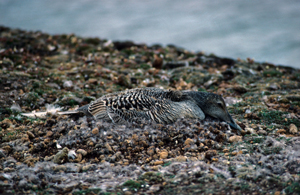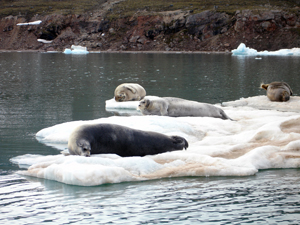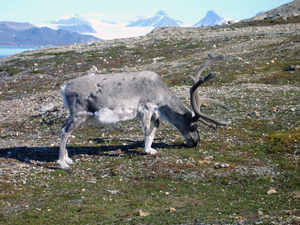Kongsfjorden's and Krossfjordens's wildlifeBy Øystein Overrein
You can register your observations of marine mammals around Svalbard in the Norwegian Polar Institute’s database Marine Mammals Sightings. 






The fjord system Kongsfjorden/Krossfjorden has a great number of small and large bird cliffs utilized by several thousands of seabirds in total. Sailing in to Ny-Ålesund, one passes the cliff Stuphallet, with a great colony of northern fulmars, black-legged kittiwakes and some Atlantic puffins. At the Ossian Sars bird cliff, black and Brünnich’s guillemots nest. Protected as bird sanctuaries since 1973, the islands and islets in Kongsfjorden hold a large nesting population of common eider. In the period 1982-2002 the nesting population fluctuated between 1000 and 4500 pairs. In 2013 the population was drmaticly reduced to under 2000 pairs. One plausibel explanation is poor access to food. On the islands, the number of nesting barnacle geese has increased to 250-300 pairs and the density of geese seems to have reached its maximum level. Nesting at the Blomstrandhamna Bird Sanctuary is a great number of common eider, as well as some pink-footed geese and barnacle geese. The Kapp Guissez Bird Sanctuary also holds a large population of common eider. Along the side of Krossfjorden, bird cliffs are located as densely as pearls on a string. A sizeable bird cliff is located in Casimir-Perrierkammen in the bay of Fjortende Julibukta, where many northern fulmars, black-legged kittiwakes, Brünnich’s and black guillemots and Atlantic puffins nest. The same species of seabirds are also found in the mountains of Generalfjella, south of the bay of Tinayrebukta, and in Kongshamaren, at the very end of Kong Haakons Halvøy. In Tinayrebukta there are three bird cliffs, housing black-legged kittiwakes and little auks. Similar bird cliffs are also found in Kollerfjorden. At the headland of Nilspynten, on the west side of Lilliehöökfjorden, there is a notable bird cliff with black-legged kittiwakes, little auks, Brünnich’s and black guillemots and Atlantic puffins. The nearest bird cliff on the same side of the fjord lies all the way out in Willeberget, outside Ebeltofthamna. Predatory glaucous gulls and, often, Arctic foxes are associated with bird cliffs. Several glaciers calve into the sea in this fjord, which accounts for the occurrence of ringed and bearded seals. Chunks of glacier ice frozen in the annually formed fjord ice provide good conditions for the ice-dependent ringed seal. The female ringed seal excavates a lair in the snow on the ice where a single pup is born in March-April. During moulting in May-July the ringed seal spends most of its time on the ice to speed up the moulting process and save energy. In 2002, 480 ringed seals were registered in Kongsfjorden during moulting. In recent years there has been very little ice in the fjord's inner parts and the number of moulting ringed seals has remained low. The bearded seal is another common species in this area. Every year, several bearded seals give birth to their pups here, remaining into the summer. There has been extensive research on ringed and bearded seals in Kongsfjorden. Sightings of white whale are also common in this fjord. On the peninsula of Brøggerhalvøya, south of Kongsfjorden, reindeers were introduced in 1978. The population increased quickly due to high production of calves, good pasture and low winter mortality. By 1993, the population had reached 375 animals. The following winter heavy snowfall and ice-covered pastures caused extremely high winter mortality. Some animals even migrated out of the area. Over one year, the population declined to 75 individuals. Since then the population has fluctuated, but today it is around 120. Updated May 2015 |
The Cruise Handbook is also available in book formHard cover with numerous pictures - 249 pages - NOK 249.00 Norwegian Polar Institute |
 Norsk
Norsk